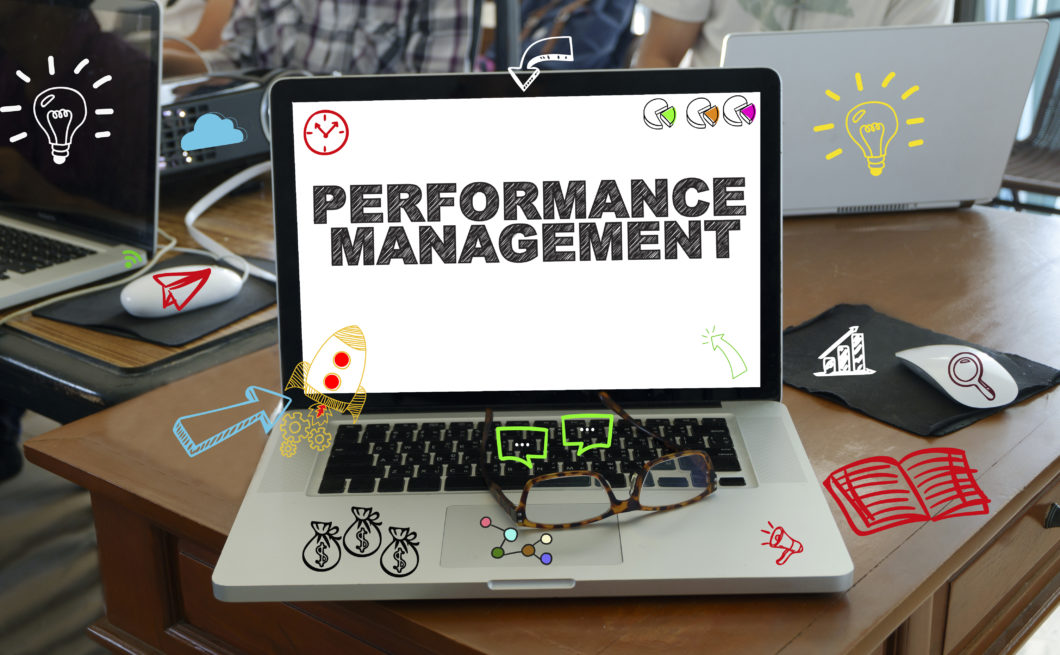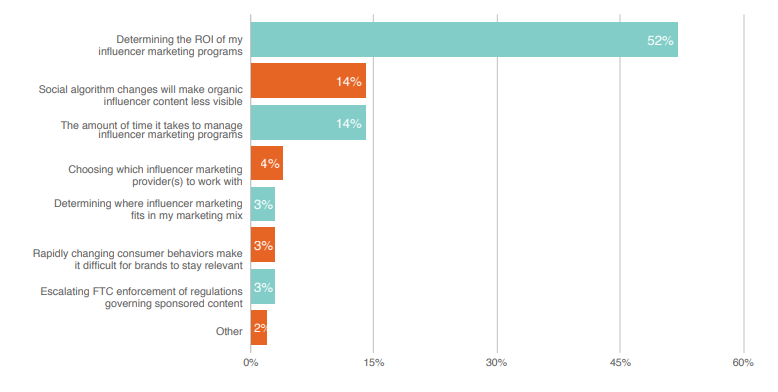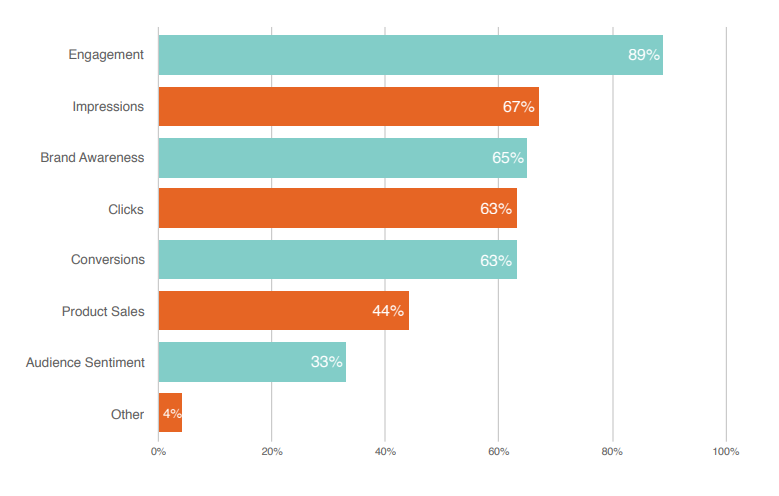12.03.20
6 Steps to Calculate Influencer Marketing ROI

Influencer marketing has become one of the most popular ways not only to build your online presence but to build an organic following using individuals who have a dedicated following and are viewed as experts in their niche. Influencers have continued to be a growing factor of marketing, branding, and building an online presence since 2014. The value of using influencer marketing according to Adweek is set to reach $10 billion this year alone. If you’re here because you’re concerned about evaluating the success of your upcoming influencer marketing campaign, we’re here to breakdown how to measure influencer marketing ROI and the types of goals you can establish in order to determine it.
When asked what the biggest influencer marketing challenges would be in 2019, here were the responses:

ROI can be hard to determine for marketers looking to determine the success of an influencer campaign by sales alone. However, with the right plan and tools it doesn’t have to be rocket science because while all brands approach their ROI differently, there are clear goals and objectives you implement within the campaign regardless of your given industry. This guide aims to help you to track your influencer campaign ROI so you can monitor and assess the success of your next campaign.
Set Goals for Your Influencer Marketing Campaign
Measuring ROI on influencer marketing depends on your objectives whether you’re looking to improve brand advocacy, promote a new product, or reach a new audience. Before even thinking about what types of influencers to reach out to, it’s important to have well-defined goals for your campaign. Knowing your objectives helps you narrow down the types of influencers you’ll want to work with, what social media platform data needs to be obtained, and what kind of content you want the influencers to post.
It may be the case that you want to rework your brand’s image while also improving other social campaigns. These two objectives would help shape your big-picture goal for your campaign.
Specify Your Goals
Let’s talk about big-picture goals when it comes to developing your influencer marketing campaign. As you are developing your strategy, you want to be as specific as possible versus having broad goals. The two most common goals people have when employing an influencer are to increase brand awareness or elevate sales. Determining what your goals are ahead of time will help as you evaluate the type of influencer you want to work with and if their platform, audience, or message aligns with your overall goals. Here are a few examples of broad vs. brand-specific goals you can use to inspire your influencer marketing campaign.
- I want to rework my brand’s image → My brand needs more visibility to showcase the changes.
- I also want to increase conversions from my email campaign → We need to buy the content posted by the influencers to use in email marketing.
So, why does your influencer campaign goal impact your ROI calculations?
Simple. Some metrics will be more important than others.
Determine the Important Metrics for Your Campaign
Metrics are a vital aspect of monitoring the success of your campaigns because it is tangible ROI. These are analytics and real-time performance numbers that can be accessed on most social platforms. To measure the ROI of an influencer marketing campaign, you’ll be looking at several of these metrics:
- Impressions
- Engagement
- Clicks
- Reach
- Conversions
- Product sales
Your game plan now might look like this:
- I want to rework my brand’s image → My brand needs more visibility to showcase the changes → The ROI of this campaign depends mostly on impressions and engagement.
- I also want to increase conversions from my email campaign → We need to buy the content posted by the influencers to use in email marketing → The ROI of this campaign also depends on the new conversion rate of my email campaign.

If you’re not sure which metrics might coincide with your overall goal, analyzing the performance metrics used by other marketers might help you. Above are the most tracked metrics for 2019 campaigns.
Some simple metrics you can start with are engagement, number of followers, or visibility. Overall the goals you establish when you create your influencer campaign will help determine what metrics are valuable to your strategy.
Get Specific with the Numbers
So let’s say you’ve decided to focus mainly on impressions as a metric for ROI. Here’s where you have to get realistic and consider your budget.
An influencer who gets 400-500 thousand impressions may charge a few thousand dollars for a handful of posts or Instagram stories, while an influencer who gets just a couple of thousand impressions may ask for 100-300 dollars for the same work, or even just for a free product or store credit.
Strive for numbers that you can achieve, and consider whether you want many influencers with cheaper prices who will individually net lower metrics, or simply a few influencers with higher prices and better metrics.
In addition to the cost of employing the influencer, you’ll also want to budget for time and staffing, tracking tools to monitor the influencer’s success, ad costs, legal costs, and promoted posts. While the numbers can seem frustrating or even overwhelming, you want to cover all your bases as you continue to invest in developing your campaign.
Use an Influencer Tracking Platform
Rather than manually tracking your campaign ROI, look for influencer marketing platforms to help. Influencer tracking platforms can provide more granular metrics than what you see on social platforms. These will make it easier for you to accurately track your campaign performance and the performance of your influencers. Plus, you will free up time for other tasks that need manual involvement.
For us, NeoReach is now the go-to. We’ve used their platform in all of the influencer marketing campaigns for our clients, and they’ve set up their service in a way that makes the job easy on us.
NeoReach allows you to monitor real-time performance, tracking engagements, impressions, cost per impression, and cost per engagement. You can monitor the ROI of your entire campaign, while, more specifically, evaluating any individual influencer and any individual post.
Measure Each Influencer’s Contribution
If you’re using an influencer platform like NeoReach or Grin, this should be easy — but still, many marketers overlook individual performances, instead only measuring the success of the campaign as a whole. Not all influencers bring the same level of engagement, impressions, or sales to a campaign. This is why it’s extremely important that as you are assessing your campaign’s goal, you select influencers that align with the overall strategy.
A successful campaign is certainly the goal, and if there were a few underperforming posts along the way don’t let that deter your success. Social media is changing daily and even the best campaigns can suffer from the platform updates and changing algorithms. But as you’re progressing through a campaign, you can identify what posts and what types of influencers aren’t getting the metrics you want, and avoid them for the remainder of your campaign.
You can later add influencers to the campaign who, based on your data, will likely get you the metrics you’ve planned for. From there you can continue the cycle of optimizing your influencer and post selections.
We count the influencers impressions after three days since it falls off pretty hard in terms of added impressions so may say you need to set a time frame to measure over so that influencers can be paid promptly for their services
Getting the Bottom Line
Regardless of any other goals you initially set for your campaign, you’re at least curious about how much revenue your business immediately accrued from your efforts.
The thing is — not everyone makes a purchase the moment they see an influencer’s post. Still, there are a few ways to continuously track the sales you’ve earned from the campaign.
Custom Promo Codes
Most e-commerce hosting sites allow you to create promo codes that you can provide to your influencers. These codes will allow you to track the impact of your influencer campaign beyond immediate sales. The greatest benefit here is that you’ll be able to test the longevity of your campaign — how long after the campaign has ended will the promo codes no longer generate sales.
Custom URLs
Creating a custom URL on your e-commerce site for each influencer is a simple way to track how many people were at least enticed into a purchase because of an influencer’s post. Trackable links help to evaluate clicks, abandoned carts, email captures, or sales as you monitor the performance of the influencer.
Google Analytics Events
By setting up an Event in Google Analytics, you can learn how many people visited your e-commerce site from an influencer’s social media platform. This in turn helps you evaluate the monetary ROI from your influencer selection. For help setting up a Google Analytics Event, click here.
Isolated Marketing
If you plan on running several influencer marketing campaigns in the future (which we do encourage), isolated marketing may be a great way to first approach the strategy. Isolated marketing defines the concept of picking a single product and only promoting it with one strategy, which in this context, would be an influencer campaign. The sales of that product would owe themselves almost entirely to the campaign. This will give you a decent estimate of the financial ROI of the campaign, and help you gauge the total sales you can expect from future campaigns.
Make your Next Campaign a Success
An influencer marketing campaign has the most success when it has the most thought and planning behind it. A detailed measurement strategy, consistent monitoring, and frequent adjustments. With this guide, we hope you can more easily monitor your campaign and work toward an influencer marketing ROI that exceeds your expectations.